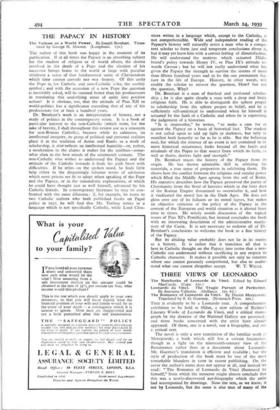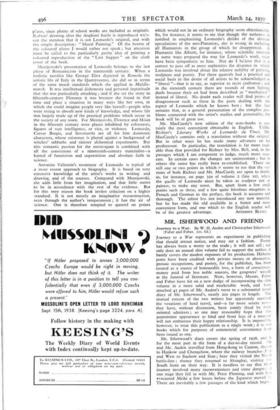THREE VIEWS OF LEONARDO
THIS is evidently to be a Leonardo year. A comprehensive exhibition to be held at Milan, a new edition of Richter's Literary Works of Leonardo da Vinci, and a critical mono- graph by the director of the National Gallery are promised ; and three books concerned with the artist have already appeared. Of these, one is a novel, one a biography, and one a critical text.
The novel is only a new translation of the familiar work of Merejcovski, a book which still has a certain fascination, though as a light on the nineteenth-century view of the Renaissance rather than as a document about Leonardo. Mr. Guemey's translation is efficient and readable ; but the style of production of the book must be one of the most remarkable blunders in taste in recent publishing. On the cover the author's name does not appear at all, and instead we read : "The Romance of Leonardo da Vinci illustrated by himself," from which the innocent might almost conclude that this was a newly-discovered autobiography which the artist had accompanied by drawings. Now the text, as we know, ts not by Leonardo, but the same is also true of many of ths
p!ates, since plenty of school works are included as originals. Rabens' drawing after the Anghiari battle is reproduced wit:t- out the mention that it is not Leonardo's original, and with the simple description : "Mural Painting." Of the horror of the coloured plates I would rather not speak ; but attention must be called to the particularly pretty idea of printing a coloured reproduction of the " Lakt Supper" on the cloth cover of the book.
Merejcovski's presentation of Leonardo belongs to the last phase of Romanticism in the nineteenth century. When a realistic novelist like George Eliot depicted in Romola the artistic life of Italy in the Quattrocento, she did so in terms of the same moral standards which she applied in Middle- march. It was intellectual dishonesty and personal ingratitude that she was particularly attacking ; and if she set the story in fifteenth-century Florence it was because she found in that time and place a situation in many ways like her own, in which she could imagine people very like herself—people who were trying to absorb new kinds of knowledge, and whose life was largely made up of the practical problems which occur in the society of any town. For Merejcovski, Florence and Milan in the fifteenth century were places inhabited by colossuses, figures of vast intelligence, or vice, or violence. Leonardo, Caesar Borgia, and Savonarola are all for him daemonic characters, whose existence is played against a background of witches' sabbaths and sinister alchemical experiments. But this romantic passion for the extravagant is combined with all the convictions of a nineteenth-century materialist—a hatred of fanaticism and superstition and absolute faith in science.
Antonina Vallentin's treatment of Leonardo is typical of a more recent approach to biography. It is based on very extensive knowledge of the artist's works in writing and drawing, and of the sources. Compared with Merejcovski, she adds little from her imagination, and that little seems to be in accordance with the rest of the evidence. But for this very reason the book invites criticism on a higher standard. It is not merely an imaginative reconstruction, seen through the author's temperament ; it has the air of science. One is therefore tempted to quarrel on points
which would not in an ordinary biography seem objectionable. So, for instance, it seems to me that though the authoress is justified in emphasising Leonardo's dislike of the abstract speculations of the neo-Platonists, she is wrong in including all Humanists in the group of which he disapproved. A Humanist like Alberti, for instance, whose scientific interests in some ways prepared the way for Leonardo's work, must have been sympathetic to him. Nor do I be:ieve that it is correct to pass off as mere sophistries the disputes in which Leonardo was involved about the relative nobility of painting, sculpture and poetry. For these quarrels had a practical and social basis in the desire of all artists to be acknowledged as "liberal "—that is to say, as superior to mere craftsmen ; and in the sixteenth century there are records of men fighting duels because their art had been described as " mechanical " instead of liberal. No doubt each reader will find points of disagreement such as these in the parts dealing with the aspect of Leonardo which he knows best ; but the fact remains that, as a general presentation of the complex pro- blems connected with the artist's studies and personality, the book will be of great use.
Mr. MacCurdy's new edition of the note-books is cer- tainly the most convenient obtainable in English. Unlike Richter's Literary Works of Leonardo da Vinci, Mr. MacCurdy's contains only a translation without the original. But in other ways he has made many advances on his predecessor. In particular, the translation is far more read- able than that provided for Richter by Mrs. Bell, and, in the passages which I am competent to judge, much more accu- rate. In certain cases the changes are unimportant ; but in others the sense has really been re-established. There are still one or two points in which it seems to me that the ver- sions of both Richter and Mr. MacCurdy are open to doubt, as, for instance, on page 320 of volume 2 (line o), where the quello of Leonardo must be taken as sculptor not as painter, to make any sense. But, apart from a few small points such as these, and a few quite frivolous misprints in French and German in the preface, the book is accurate and thorough. The editor has not introduced any new material, but he has made the old available in a better and more convenient form, and one which to the English reader will be of the greatest advantage. ANTHONY BLUNT.















































 Previous page
Previous page